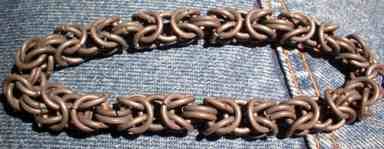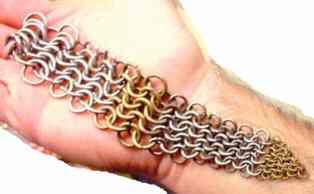 Claude de la Beche
Claude de la Beche
You should too. Everyone should make mail.
OverviewMail armour predates the Roman empire: earliest finds are in graves of Scythian warriors, 5th century BCE. The Romans' first contact with chain mail was through Celtic tribes in Gaul. Early on it was used solely to prevent bits of warriors being carved away by swords. Now it's used by divers to prevent bits of them from being gnashed by sharks and by butchers to reduce the finger content of ground beef. It was originally made by linking four closed iron loops into a fifth and riveting that one closed. However, that's extremely labour intensive so most mail is now made out of steel that is hard enough not to require riveting. The mail I make and am describing here is sometimes referred to as "butt mail" because it is made of links that are closed loops broken (not cut) off of a coil resulting in clean flat butt joint. If the wire were cut it would have pinched ends and would be more likely to fall apart when the links' joints aligned. It is possible to make different patterns of mail. For example, a pattern of every link passing through six others (three above and three below) is sometimes called "double mail" but there are no known examples of this from the medieval era. It makes rather heavy and less flexible mail. I tried it and didn't like it much. SizeThere're definite pairs of wire gauge and link diameters that yield the most pleasing look and feel to mail. After some trial and error I have settled on these. The winding rod colour codes may or may not be standard for steel rods at hardware stores. Memorize it; you'll be tested later.
If you stray much beyond these suggested servings you'll end up with mail that is to open and doesn't provide adequate coverage or is too closed, is heavy and inflexible. ("heavy" is a relative term here; this is steel we're speaking of so it's all heavy.) ToolsYou'll want:
MaterialsFor steel wire, I use galvanized electric fence wire. I 've found that a farm co-op store is a good source. For brass, I use anything I can get my hands on because it's so hard to come by. You may have to have it ordered especially and buy some minimum like 50 lbs. of it. Apparently, some poor misguided fools use aluminum. I guess they don't appreciate the sensation of 60 lbs. of steel being carried on your knees for hours. Go figure. MethodMake the coils:
|
Make the links:
Weave the mail:
Shape the garment:
|


Here's a bracelet made from a very different link pattern (see if you can duplicate it.) and a sampler of different sizes of links and metals.
'Nuff said?
Go look at M.A.I.L (Maille Artisans International League) and Chainmail basket.
Last Updated on Fri, Jun 4, 2010.